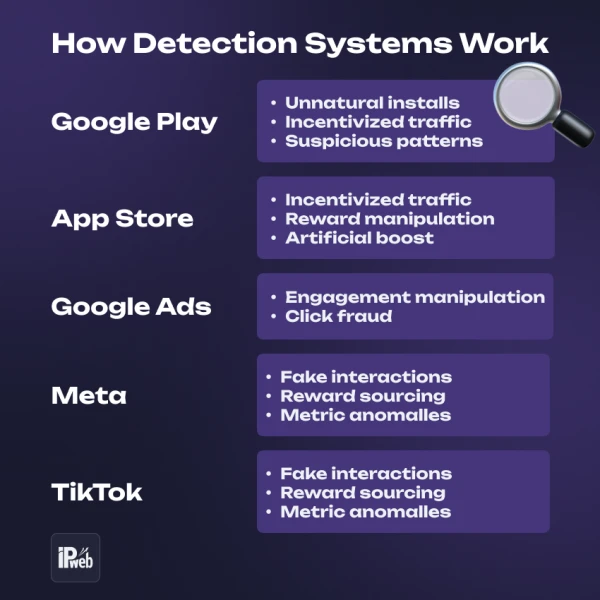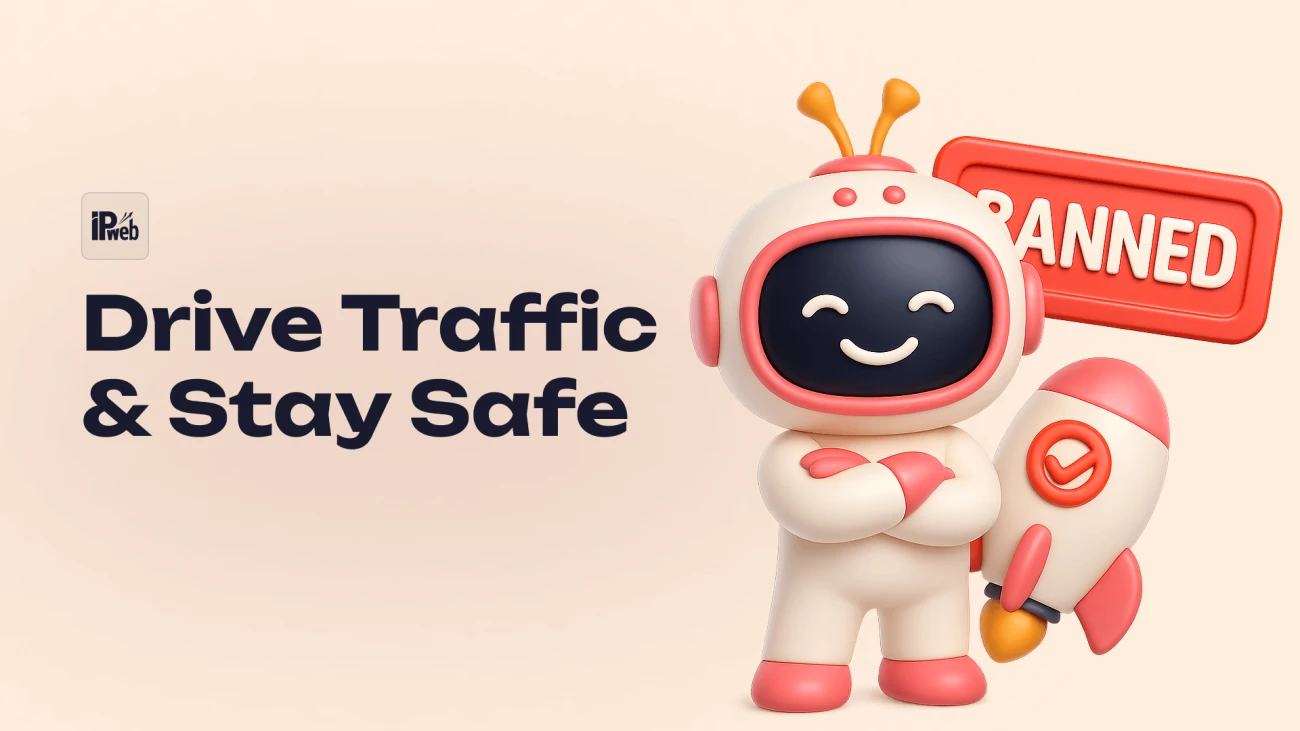Motivated traffic remains one of the most discussed tools in digital marketing. It’s fast, affordable, and incredibly effective when handled properly. Marketers use it to boost app installs, website visits, and social media engagement almost instantly. However, the popularity of motivated traffic also brought increased scrutiny from major platforms.
Google Play, the App Store, Meta, and other ecosystems have tightened their policies against any form of manipulated engagement. Traffic compliance today is more than a best practice — it's a necessity if you want your campaigns to survive. Algorithms are constantly evolving to detect unnatural patterns, such as click fraud, fake engagement, or suspicious spikes in installs.
Ignoring safe user acquisition strategies can lead to serious consequences: ad account suspension, sudden drops in visibility, or even getting banned from app stores altogether. And once your platform trust score drops, restoring it becomes an uphill battle.
That’s why understanding the promotion risks, knowing how traffic policies work, and mastering the art of clean campaign setups are essential skills for 2025. Done right, incentivized traffic can still drive massive growth — without setting off red flags. This guide will show you how to leverage motivated users safely across websites, apps, and social media without crossing the line.
What Is Motivated Traffic and Why Use It?
Motivated traffic refers to users who interact with your website, app, or social media content in exchange for a reward. This reward could be anything from points in a loyalty program to a small monetary incentive. The key difference from organic traffic is the presence of external motivation driving user actions like installs, page visits, or social media engagement.
Marketers leverage motivated traffic for several reasons. It’s an efficient way to boost early engagement metrics, accelerate app installs, improve social media engagement, or create momentum for a new website. Especially when launching a product or trying to rise in store rankings quickly, incentivized users can help demonstrate initial interest, increase visibility, and trigger platform algorithms to recommend your content to a wider organic audience.
When used correctly, incentivized traffic can fit into safe traffic promotion strategies, creating a natural-looking growth curve that supports broader marketing goals. The secret lies in targeting the right users and ensuring their actions resemble genuine, non-rewarded behavior.
For compliant and performance-oriented solutions, professional services like IPWeb offer carefully filtered motivated traffic tailored for websites, apps, and social networks — helping you grow without crossing the line.
Common Risks When Using Motivated Traffic
While motivated traffic can be highly effective, using it carelessly introduces serious promotion risks. Platforms today have powerful detection systems that monitor user behavior, and any sign of manipulation can trigger penalties.
App Store and Ad Platform Bans
Both Apple and Google Play have strict app store policies regarding incentivized traffic. They expect organic user behavior — real interest, genuine installs, and authentic engagement. Detection systems track:
- Unusual spikes in installs without corresponding engagement
- High uninstall rates within the first 24–48 hours
- Identical behavior patterns across user accounts
Violations like unnatural installs or fake engagement can get your app removed from stores, making it extremely hard to recover reputation and rankings.
Account Suspensions and Penalties
Ad networks such as Meta, TikTok, and Google Ads have tightened their traffic compliance rules. If they detect behavior manipulation or incentive-based clicks without proper disclosure, they can:
- Suspend your advertising account
- Freeze your ad budgets
- Reduce your ad quality score, making future campaigns less effective
Recovering from an ad account suspension is costly and time-consuming, often requiring manual reviews and long waiting periods.
Declining Retention and High Uninstall Rates
If motivated users only perform superficial actions — installing but not engaging — it hurts important performance indicators like:
- Retention rate
- Session duration
- Event completion rates
Poor user retention and high uninstall rates signal low content quality or misaligned targeting to app stores and ad algorithms, which can sink your search rankings or visibility.
Understanding Platform Policies and Detection Systems

Navigating the rules of different platforms is essential if you want to use motivated traffic without risking bans. Every major store and ad network now actively enforces policies designed to detect and punish artificial engagement.
App Store Policies on Incentivized Installs
Both Google Play and the Apple App Store explicitly discourage or outright ban certain types of incentivized traffic. Apple's Developer Program policies state that any method artificially inflating app installs or rankings can result in removal from the store. Similarly, Google's Play Console policies warn against deceptive acquisition methods, including incentivized installs without clear user intent.
Key red flags include sudden install spikes, low retention rates, and patterns suggesting mass low-quality engagement. Even if motivated traffic isn't banned outright, failure to align with behavioral compliance expectations can quietly destroy your store rankings without warning.
Social Media and Ad Network Rules
When it comes to advertising, platforms like Meta (Facebook), TikTok, and Google Ads also implement strong anti-fraud systems. Meta, for example, uses machine learning to flag "unnatural engagement behavior," including engagement manipulation linked to incentive-based campaigns. Google Ads enforces strict traffic compliance policies, and violations can trigger an ad account suspension after just one warning.
Most platforms tolerate user acquisition promotions if user motivation is disclosed properly (e.g., "Get rewarded for trying an app") and if real post-click engagement occurs. Transparency and high engagement quality are critical to stay within acceptable limits and avoid promotion risks.
Understanding these rules isn’t just about avoiding bans — it’s the foundation for building long-term, sustainable campaigns that leverage motivated traffic safely.
Safe User Acquisition Strategies with Motivated Traffic
Using motivated traffic effectively requires more than just buying clicks or installs. Without a strategic approach, campaigns can quickly trigger platform warnings or penalties. A smart safe traffic promotion plan begins with understanding how to guide users toward natural engagement.
Pre-Qualifying the Audience
Not all users are created equal. To reduce bounce rates, minimize fake engagement, and lower the risk of high uninstall rates, it's critical to pre-select users who have a real interest in your offer. Good traffic sources allow you to target based on category relevance, demographics, or behavioral patterns. By narrowing the pool upfront, you boost your chances of natural interactions, improving both your retention rate and traffic conversion metrics.
Combining Incentivized and Organic Campaigns
Blending incentivized traffic with organic growth is a powerful tactic. When you alternate motivated bursts with organic promotion — like SEO content, social media engagement, or influencer mentions — you create more natural-looking spikes and engagement patterns. This method supports traffic compliance and significantly reduces the risk that algorithms flag your campaign as manipulative.
Creating Behavioral Compliance
Guiding motivated users to behave authentically is essential. Simple instructions like encouraging users to browse several screens, stay on the page for a certain time, or explore related content help simulate organic behavior. This enhances algorithm signals, strengthens app store policies compliance, and supports the long-term health of your app, site, or social media account.
Building a campaign on safe user acquisition strategies ensures that motivated traffic becomes a growth tool — not a liability.
How to Choose Safe Motivated Traffic Providers
Selecting the right partner for motivated traffic is critical for maintaining safe traffic promotion and avoiding unnecessary promotion risks. Not every vendor plays by the rules — and working with the wrong one can cost you your account.
Warning Signs of Risky Vendors
When evaluating providers, be cautious if you notice instant mass delivery without behavior filters, poor or no audience targeting, missing data on traffic quality metrics, or vendors that promise guaranteed rankings. These are classic signs that could lead to ad account suspension or app store penalties.
Advantages of ipweb.pro as a Traffic Platform
One reliable option is https://www.ipweb.pro, which focuses on traffic compliance. They allow detailed targeting, behavioral instructions for users, and provide analytics to monitor engagement metrics and conversion paths. This quality filtering greatly reduces risks and supports safe user acquisition strategies across websites, apps, and social media.
Advanced Tips to Avoid Getting Banned
Even when using safe traffic promotion methods, applying extra precautions is essential. Here are proven strategies to further minimize promotion risks:
- Use Deep Links: Direct users straight to specific in-app actions or key pages to simulate natural user flow and improve engagement metrics.
- A/B Test with Small Volumes: Before scaling, test your campaigns with small batches to detect any anomalies or red flags early.
- Event-Based Targeting: Focus on users who complete real actions—like browsing products or filling out forms—rather than just installing or visiting.
- Smart Timing and Frequency Capping: Spread out user actions over time to avoid unnatural traffic spikes that trigger traffic compliance checks.
- Platform-Specific Retention Strategies: Adapt your engagement model based on platform norms — for example, longer dwell times on content apps, faster interactions on gaming apps.
Following these tips helps align motivated traffic behavior with normal user expectations across major platforms.
Case Study: How a Mobile App Avoided a Ban Using Motivated Traffic Safely
One lifestyle app wanted to boost installs without risking a get banned from app store penalty. They partnered with a compliant motivated traffic provider. By using deep links, encouraging real exploration of app features, and maintaining a steady, non-spiked install pattern, the app improved its retention rate by 18% and avoided any policy violations. In 60 days, they secured a 25% boost in store rankings — all while staying under detection thresholds.
FAQ Block
Is motivated traffic allowed on Google Play or Apple App Store?
Direct incentivized installs are against both platforms’ rules. However, with proper user engagement and retention strategies, you can use motivated traffic without getting banned from app store policies.
How to prevent an ad account suspension when using incentivized traffic?
Use gradual scaling, target relevant audiences, combine organic methods, and carefully monitor behavioral patterns to avoid triggering fraud detection algorithms.
What user behavior metrics are most important for avoiding bans?
Focus on retention rate, dwell time, interaction depth, uninstall rate, and genuine engagement. These metrics help signal organic behavior to platform detection systems.
Can I use motivated traffic for YouTube or Instagram promotion?
Yes, but ensure users perform meaningful actions like video views, likes, or follows naturally, avoiding obvious artificial engagement that may lead to account restrictions.
What’s the best way to test motivated traffic safely?
Start with low traffic volumes, use trusted vendors, monitor platform analytics closely, and gradually scale up only after confirming positive, natural-looking behavioral compliance.
Internet Marketer
